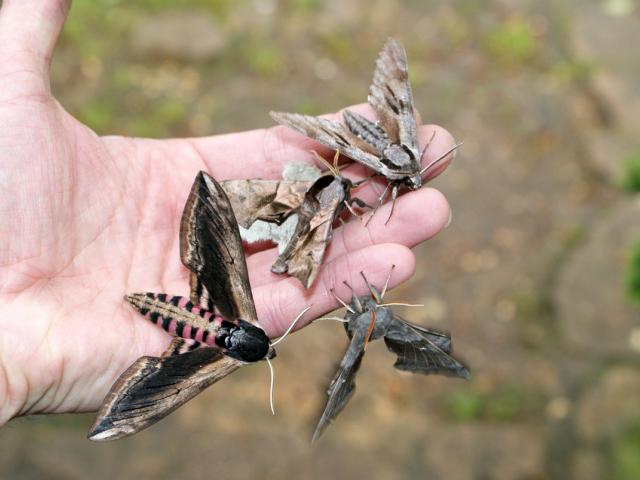

Moths far outnumber butterflies and are much more varied, and learning about the many species in your own area is a fascinating and enjoyable hobby.
Moths have also received far less attention than butterflies and, as a result, less is known about them and where they occur. This means that the information you collect about your local moths can make a real contribution to knowledge and can directly help conservation.
Since moths are so diverse and numerous, information about them is also valuable because, like the canary in the coalmine, they tell us how healthy our environment is. That’s one of the reasons why Butterfly Conservation wants people of all ages, all over the country, to take an interest in the many types of moths around them, so that we can all be “citizen scientists” helping to build a better understanding of wildlife and the environment.
Where can you find moths?
You can find moths almost anywhere, not just in the countryside but in gardens, urban parks and patches of waste-ground, even in the busiest cities. Some species are only found in certain habitats or near certain types of plant, but many are widespread. More than a hundred species could be living in your own back garden or local park, so those are the best places to start looking.
When can you find moths?
Moths are around all through the year, though different species are found in different seasons, with the greatest variety in summer. If you want to see every type of moth that lives in your garden, you will need to look throughout the year. Moths are more active, and so more likely to be seen, on mild, cloudy, still nights. They don’t like cold nights, heavy rain or strong winds. If you use light to attract moths, it will work best on moonless nights.

Who can find moths?
One of the wonderful things about moths is that, unlike most other wildlife, they can be seen close up by almost anyone, young or old. There’s no need for expensive equipment or travel; you don’t need to live in the countryside or have a large garden; you don’t have to be fit or particularly active; you don’t have to go far from your own back door, and some moths will even come to you if you leave the curtains or window open!
How can you find moths?
You can use several methods to attract adult moths, none of which will kill or harm them.
- Flowers and fruit - Most flowers that attract butterflies also attract moths, which come to feed on nectar both at night and by day. Flowers particularly attractive to moths include those of buddleia, red valerian, heather, sallow and ivy. You can try searching flowering plants with a torch for an hour or two after dusk. Overripe fruit can also attract moths.
- Sugaring - Moths will also come to artificial nectar called “sugar”. Heat about 500ml of brown ale (or cola) in a large pan and simmer for five minutes. Then stir in and dissolve about a kilogram of dark brown sugar, followed by a tin of black treacle. Simmer the mixture for two minutes and then allow it to cool before transferring it to a suitable container for carrying outside. A drop of rum stirred in before use is recommended, but not essential. Just before dusk, use a brush to paint the mixture at eye level onto tree trunks or fence posts. Check the “sugar” for moths with a torch during the first two hours of darkness.
- Wine Ropes - An alternative method to sugaring uses thick cord or cloth made from absorbent material. Heat a bottle of cheap red wine in a pan, stir in and dissolve a kilogram of sugar and, after cooling, soak metre lengths of the cord or twisted cloth in the mixture. Drape these “wine ropes” over low branches, bushes or fences just before dusk and later check for moths by torch-light.
- Light - It is well known that moths are attracted to lights at night, though the reason for this remains unclear. Try leaving an outside or porch light on after dark, and look for moths on lighted windows or lit walls and fences. Low-energy bulbs attract moths and are better for the environment. A white sheet hanging up with a bright torch shining on it can also be effective. Some moths will settle on window panes if curtains are left open, or will come into light through an open window - but to make sure only moths come in, close it before you go to bed!
- Light traps - The best way to see lots of moths is to use specifically designed moth traps. A trap running on a muggy night in July/August can catch over a thousand moths of up to a hundred species! A moth trap is basically a box with a special lamp inside and something for the moths to perch on or hide in. Three common kinds are available for sale, all with different advantages and disadvantages and varying prices, or you can make your own.
-
Other methods - Not all moths fly at night or come to light, nectar or sugar, so those methods won’t reveal all the species in your area. Try looking for moths flying in the daytime or at dusk and catch them in a net. You may find that what you thought was a butterfly is actually a moth! You can also hunt for caterpillars feeding on plants in the garden.
Moth Welfare
- Avoid touching moths’ wings directly as you can easily damage them.
- Put moths in dry clear plastic or glass containers for close inspection.
- To dislodge moths into containers, give whatever they are resting on a sharp tap, or gently lift each moth from underneath onto a pencil.
- Only put one moth into each container and check that it can move around freely.
- If moths are very active in containers, put them in a fridge or cool box for a short time to calm them.
- Moths can be kept for a day or two in a container in the fridge while you identify them.
- Release moths out of the sight of birds in thick or long vegetation, ideally at dusk.
- Check your trap or lighted area at dawn (or cover the trap with a sheet at dawn).
- Discourage birds by using a plastic snake or owl.
- Regularly change your moth release site.

